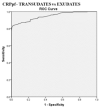Role of C-Reactive Protein in Discrimination between Transudative and Exudative Pleural Effusions
- PMID: 34829350
- PMCID: PMC8622637
- DOI: 10.3390/diagnostics11112003
Role of C-Reactive Protein in Discrimination between Transudative and Exudative Pleural Effusions
Abstract
Background: There is still no wide agreement regarding the efficacy of the serum levels of C-reactive protein (CRPs), pleural fluid levels of CRP (CRPpf), and their ratio (CRPr) in the discrimination between transudative (Tr) and exudative (Ex) pleural effusions (PEs). Most of the previous studies were conducted on small cohorts, and the role of CRPs in the CRPpf gradient (CRPg) in this discrimination has not been previously reported. The present study aims to assess the diagnostic efficacy of CRPs, CRPpf, CRPg, and CRPr in the discrimination between TrPE and ExPE in a relatively large cohort of patients with PE.
Methods: The study population included 492 patients with PE, 210 of them with TrPE and 282 with ExPE. The levels of CRPs and CRPpf were measured, and the CRPg and CRPr were calculated. The values are presented as mean ± SD.
Results: The mean levels of CRPs, CRPpf, CRPg, and CRPr of the TrPEs were 11.3 ± 5.7 mg/L, 4.6 ± 2.8 mg/L, 6.7 ± 3.9 mg/L, and 0.40 ± 0.14, respectively, and for the ExPEs, they were 140.5 ± 112.8 mg/L, 52.8 ± 53.2 mg/L, 87.2 ± 72.4 mg/L, and 0.37 ± 0.15, respectively. The levels of CRPs, CRPpf, and CRPg were significantly higher in the ExPEs than in the TrPEs (p < 0.0001). No significant difference was found between the two groups for the levels of CRPr (p = 0.15). The best cut-off value calculated by the receiver operating characteristic (ROC) analysis for discriminating TrPE from ExPE was for CRPs, 20.5 mg/L with area under the curve (AUC) = 97% and p < 0.0001; for CRPpf, 9.9 mg/L with AUC = 95% and p < 0.0001; and for CRPg, 13.6 mg/L with AUC = 96% and p < 0.0001.
Conclusion: CRPs, CRPpf, and CRPg are strong markers for discrimination between TrPE and ExPE, while CRPr has no role in this discrimination.
Keywords: C-reactive protein; exudate; pleural effusion; transudate.
Conflict of interest statement
The authors declare no conflict of interest.
Figures







References
-
- Valdés L., San-José E., Ferreiro L., Golpe A., González-Barcala F.J., Toubes M.E., Rodríguez-Álvarez M.X., Álvarez-Dobaño J.M., Rodríguez-Núñez N., Rábade C., et al. Predicting malignant and tuberculous pleural effusions through demographics and pleural fluid analysis of patients. Clin. Respir. J. 2015;9:203–213. doi: 10.1111/crj.12125. - DOI - PubMed
-
- Villena Garrido V., Ferrer Sancho J., Hernández Blasco L., de Pablo Gafas A., Pérez Rodríguez E., Rodríguez Panadero F., Romero Candeira S., Salvatierra Velázquez A., Valdés Cuadrado L., Area de Tecnicas Y. Diagnosis and treatment of pleural effusion. Arch. Bronconeumol. 2006;42:349–372. doi: 10.1157/13090586. - DOI - PubMed
-
- Sahn S.A., Heffner J.E. Pleural fluid analysis. In: Light R.W., Lee Y.C.G., editors. Textbook of Pleural Diseases. 4th ed. Arnold Press; London, UK: 2008. pp. 209–226.
-
- Light R.W. Disorders of the pleura. In: Jameson J.L., Kasper D.L., Longo D.L., Fauci A.S., Hauser S.L., Loscalzo J., editors. Harrison’s Principles of Internal Medicine. 20th ed. McGraw-Hill Education; New York, NY, USA: 2018. pp. 2006–2009.
LinkOut - more resources
Full Text Sources
Research Materials
Miscellaneous

